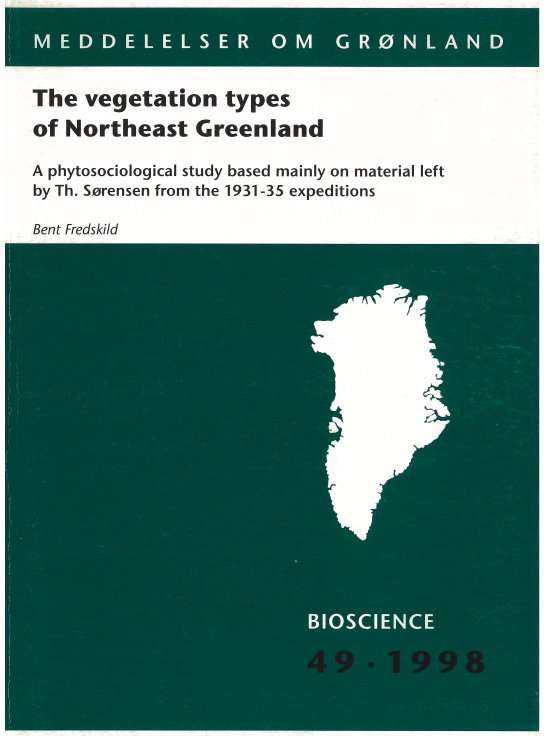The vegetation types of Northeast Greenland. A phytosociological study based mainly on material left by Th. Sørensen from the 1931-35 expeditions
DOI:
https://doi.org/10.7146/mogbiosci.v49.142598Abstract
Based on 347 vegetation analyses carried out in 1931-35 by Th. S0rensen in the 72°- 74°N area, supplemented by 136 recent analyses from 74½0N and field observations northwards to 79°N, the vegetation types of Northeast Greenland are described. Further to phanerogams, the mosses and a few lichens are determined in 274 of the 347 analyses.
The most characteristic vegetation types present in this middle-arctic area are: 1. Dwarfshrub heaths dominated by Cassiope tetragona, Salix arctica, Vaccinium uliginosum ssp. microphyllum or Betula arctica, depending on soil and duration of snow cover. 2. Grasslands, drying out during summer, characterised by Arctagrostis latifolia, Carex bigelowii, C. misandra, and Eriophorum triste. 3. Permanently wet fens with Carex stanus, Eriophorum scheuchzeri, and Arctagrostis latifolia. 4. Snowbeds, the late ones characterised by Phippsia algida, the moderately late by Salix herbacea, and the few early herb-slope like snowbeds by Trisetum spicatum and Erigeron humilis. 5. Open, graminoid Dryas-heaths and fell-fields on dry soil with Carex nardina, C. rupestris, and Kobresia myosuroides. 6. Fell-fields with Calamagrostis purpurascens and Carex supina ssp. spaniocarpa. 7. Species rich communities on wet ground, covered by organic crust, characterised by Koenigia islandica and Festuca hyperborea. 8. Halophytic vegetations with Puccinellia phryganodes and Carex subspathacea.
Soil samples have been analyzed for nine factors for the major part of the 347 analyses. The plant to soil relationship is illustrated for the 109 most frequent phanerogam species, for 40 of these lo all nine factors, for 69 only to pH and conductivity.
Sørensen arranged his analyses in 41 phytosociological groups according to his similarity coefficient - the "Sørensen index''. These groups form the basis of the phytosociological classification according to the Braun-Blanquet system. The vegetation units are grouped into 13 associations, of which 7 are new, subdivided into a number of new, lower phytosociological units. These are grouped in the alliances Saxifrago-Ranunculion nivalis, Caricion atrofusco-saxatilis, Dryadion integrifoliae, Veronico-Poion glaucae, and Puccincllion phryganodis. Two synoptical tables summarizes the frequency of 135 phanerogams and 99 cryptogams, mainly mosses, in 42 phytosociological units.

Downloads
Published
Issue
Section
License
Coypyright by the authors and the Commision for Scientific Research in Greenland / Danish Polar Center/Museum Tusculanum Press as indicated in the individual volumes. No parts of the publications may be reproduced in any form without the written permission by the copyright owners.

